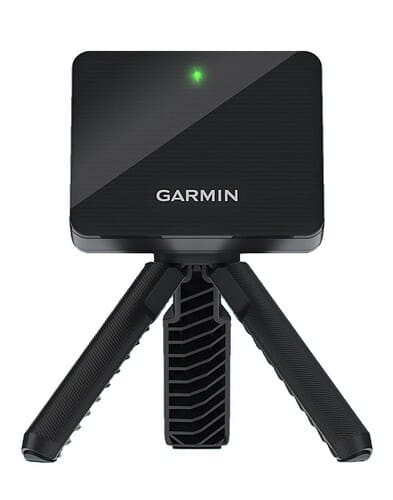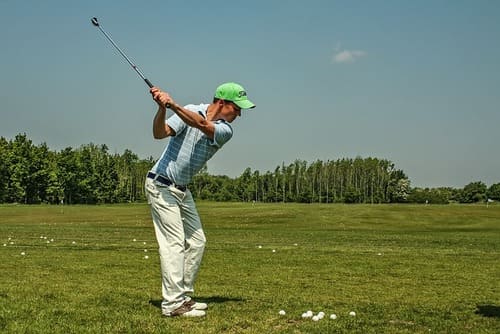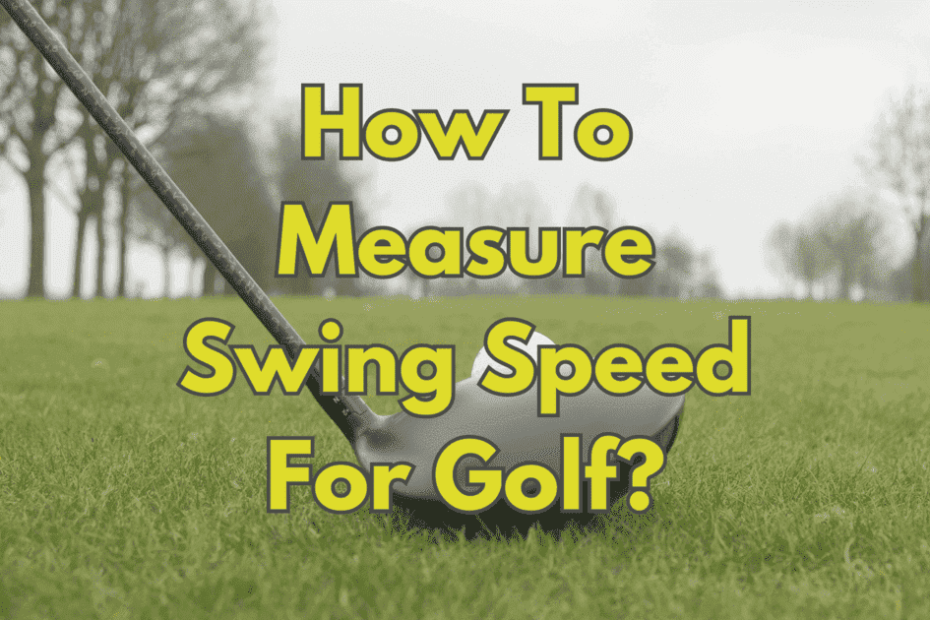Swing speed is a crucial element in the game of golf, as it directly impacts the distance that a ball can travel. When a golfer swings the club faster, it generates more power and momentum, resulting in a longer shot. Therefore, understanding and improving swing speed is essential for golfers who strive for greater distance and control over their shots. But how do you measure your swing speed in golf?
Understanding the Importance of Swing Speed in Golf
In golf, the speed at which a player swings the club can make a significant difference in the outcome of a game. The higher the swing speed, the further the ball will travel, allowing the golfer to reach the green with fewer strokes. Additionally, increased swing speed can also translate to more spin on the ball, facilitating better control and shaping of shots. Therefore, golfers of all skill levels should recognize the importance of swing speed. You should work to improve it for enhanced performance on the course.
The Science Behind Swing Speed and its Impact on Distance
Swing speed is a crucial factor in determining the distance a golf ball will travel. The velocity at which the golf club head strikes the ball directly affects the amount of energy transferred, ultimately translating into distance. It is a fundamental principle of physics that the greater the speed of the club head, the more force is exerted on the ball, resulting in longer shots.
Several key factors play a role in understanding the science behind swing speed and its impact on distance. The first is club head weight, which directly affects how fast the club head can be swung. A lighter club head allows for increased speed, leading to more distance, while a heavier club head requires more power and may reduce swing speed. Additionally, the position of the club face and the angle of attack at impact influence the efficiency of energy transfer from the club to the ball. Proper alignment and technique are crucial in maximizing swing speed and distance in golf.
Equipment Needed to Measure Swing Speed accurately

Swing speed is a crucial factor in determining the distance and accuracy of a golf shot. To accurately measure swing speed, you will need the right equipment. One of the most common tools used to measure swing speed is a launch monitor. A launch monitor utilizes advanced technology to track various aspects of the golf swing, including clubhead speed, ball speed, and launch angle. These devices provide accurate and real-time data, allowing golfers and instructors to analyze and fine-tune their swing techniques.
Another essential piece of equipment for measuring swing speed is a quality radar-based tracking system. These systems use radar technology to track the speed of the clubhead as it moves through the impact zone. By capturing the clubhead speed at impact, golfers can gain insights into their swing mechanics and make necessary adjustments to optimize their performance. It is important to invest in a reliable radar-based tracking system that can accurately capture the critical data required to improve swing speed in golf.
Preparing Yourself for Swing Speed Measurement
Before measuring your swing speed, it is important to ensure that you are adequately prepared for the process. Firstly, make sure you have the necessary equipment in place. This includes a launch monitor, which is a device used to measure various aspects of your swing, including swing speed. Additionally, ensure that your golf club is in proper condition, as any damage or wear can affect the accuracy of the measurements.
Once you have the necessary equipment, it is essential to warm up properly before taking your swing speed measurement. Stretching exercises and a few practice swings will help loosen your muscles and prepare your body for the force exerted during the swing. This will not only help prevent injuries but also ensure that you can generate maximum power and speed during the measurement process. Remember to remain focused and relaxed throughout the warm-up routine to achieve the best possible results.
Step-by-Step Guide to Measuring Swing Speed with a Launch Monitor
To measure your swing speed with a launch monitor, you will need to follow a step-by-step process. First, set up the launch monitor on a flat surface behind you, ensuring that it has a clear view of your swing path. Next, position yourself on the tee and prepare to hit the golf ball. Take a few practice swings to warm up and get comfortable. Once you’re ready, place the golf ball on the tee and address it with your chosen club. Keep in mind that it’s important to use the same club throughout the measurement process to maintain consistency.

Now comes the moment of truth – take a full swing and make solid contact with the ball. As you swing, the launch monitor will capture and analyze various data points, including your swing speed. This information is crucial for understanding the dynamics of your swing and how it contributes to the distance and accuracy of your shots. After the swing, take a moment to review the swing speed data on the launch monitor’s display, noting the specific numbers and any accompanying metrics such as ball speed or launch angle. This data can provide valuable insights into your swing mechanics and help you assess your performance on the course.
Alternative Methods to Measure Swing Speed without a Launch Monitor
The desire to measure swing speed without a launch monitor has led to the development of alternative methods that golfers can use. One such method involves the use of a swing speed radar device. These handheld devices are small and portable, making them easy to carry around on the golf course. By attaching the radar to the club shaft, golfers can get a real-time reading of their swing speed as they take a swing. While not as accurate as a launch monitor, these devices provide a good estimate of swing speed and can help golfers track their progress over time.
Another alternative method to measure swing speed is the use of a smartphone app. There are several apps available for download that utilize the phone’s accelerometer to measure swing speed. By placing the phone in a secure holder or attaching it to the club, golfers can capture data about their swing speed without the need for additional equipment. These apps often also provide additional features such as swing analysis and tips for improvement, making them a convenient and cost-effective option for golfers who want to track their swing speed.
Interpreting and Analyzing Swing Speed Data
When it comes to interpreting and analyzing swing speed data in golf, there are several key factors to consider. First and foremost is understanding the correlation between swing speed and distance. Generally, a higher swing speed will result in greater distance on your shots. This is because a faster swing generates more power, allowing the ball to travel further down the fairway. However, it’s important to note that other elements such as clubhead design, ball compression, and launch angle also play a role in maximizing distance. Therefore, it’s crucial to analyze swing speed data in conjunction with other factors to optimize your performance on the course.
In addition to distance, swing speed data can also provide insights into consistency and efficiency. By analyzing the variations in your swing speed from shot to shot, you can identify any irregularities or inconsistencies that may be affecting your accuracy or ball flight. Consistency in swing speed is vital for achieving reliable results and improving your overall performance. Furthermore, analyzing swing speed data can help you understand the efficiency of your swing. By comparing your swing speed with the distance achieved, you can determine whether your swing mechanics are optimized to produce the desired results. This information can then be used to make necessary adjustments and improve your swing efficiency for better scoring opportunities on the course.
Factors Affecting Swing Speed and How to Improve it
Factors affecting swing speed in golf can vary from player to player and can have a significant impact on overall performance. One such factor is the player’s physical fitness level. Stronger muscles and better flexibility can lead to increased swing speed. Engaging in regular strength and conditioning exercises, focusing on core and rotational movements, can help improve swing speed. Additionally, a player’s technique and form can greatly influence their swing speed. Proper weight transfer, arm extension, and hip rotation are fundamental elements that can contribute to generating more clubhead speed.
Another factor to consider is the equipment being used. The type of golf club, shaft flex, and grip size can all have an impact on swing speed. Using equipment that is properly suited to a player’s swing characteristics can maximize their potential for generating higher swing speeds. Club fitting sessions with a professional can help determine the most suitable equipment specifications for each individual player. By addressing these factors and making necessary adjustments, golfers can work towards improving their swing speed and ultimately enhance their overall performance on the course.
How Swing Speed Relates to Club Selection and Shot Strategy
When it comes to club selection in golf, swing speed plays a pivotal role. The speed at which a golfer swings the club greatly influences the distance and accuracy of their shots. Understanding your swing speed can help you make informed decisions about which club to use in various situations on the course.
A golfer with a slower swing speed will typically benefit from using clubs with higher lofts. These clubs are designed to launch the ball higher into the air, providing more carry distance. On the other hand, golfers with a faster swing speed can generate more power and may opt for lower-lofted clubs to achieve greater distance. Additionally, swing speed affects shot strategy, as it determines the type of shots a golfer can execute effectively. Players with higher swing speeds can generate more backspin, allowing them to control their shots and hit the green more accurately. Conversely, golfers with slower swing speeds may need to adjust their strategy to rely more on accuracy rather than distance. By understanding your swing speed and its implications, you can make better decisions on club selection and shot strategy on the golf course.
Training Exercises to Increase Swing Speed in Golf
Training exercises play a crucial role in improving swing speed in golf. By incorporating specific workouts into your training routine, you can develop the strength, flexibility, and coordination necessary to generate more power and speed in your swing.
One effective exercise to increase swing speed is the medicine ball rotational throw. Holding a medicine ball with both hands, stand with your feet shoulder-width apart and rotate your torso to one side, then explosively throw the ball as far as you can while maintaining balance. This exercise targets the muscles responsible for rotational power, such as the core and hip muscles, helping to enhance your swing speed.
Additionally, incorporating resistance band exercises can also aid in increasing swing speed. Attach a resistance band to a secure anchor point and hold the other end with both hands, standing in a golf posture. Perform a simulated swing motion against the resistance of the band, focusing on generating speed and power. This exercise helps to strengthen the muscles involved in the golf swing, further boosting your swing speed. By regularly practicing these training exercises, you can improve your overall swing speed and enhance your performance on the golf course.
FAQs
What is swing speed and why is it important in golf?
Swing speed refers to the velocity at which a golfer’s clubhead is traveling during their swing. It is important in golf because it directly affects the distance and trajectory of the ball. The higher the swing speed, the farther the ball is likely to travel.
How does swing speed impact the distance of a golf shot?
Swing speed has a direct relationship to the distance of a golf shot. Generally, the higher the swing speed, the farther the ball will travel. This is because a higher swing speed generates more clubhead speed, leading to increased ball speed and greater distance.
What equipment is needed to accurately measure swing speed?
To accurately measure swing speed, you will need a launch monitor. This device uses advanced technology to track and analyze the clubhead speed during your golf swing.
How can I prepare myself for swing speed measurement?
Before measuring your swing speed, it is important to warm up properly and ensure you are using the correct golf club. Take a few practice swings to get your body loosened up and ready for the measurement.
Can swing speed be measured without a launch monitor?
Yes, there are alternative methods to measure swing speed without a launch monitor. One method involves using a speed radar device or a swing speed radar. Another method is to utilize specialized smartphone apps that use the phone’s accelerometer to estimate swing speed.
How can swing speed data be interpreted and analyzed?
Swing speed data can be interpreted by comparing it to your previous swing speeds or the average swing speeds of professional golfers. Analyzing the data can help identify areas for improvement and track progress over time.
What factors can affect swing speed and how can it be improved?
Factors such as strength, flexibility, technique, and equipment can affect swing speed. To improve swing speed, focus on exercises and drills that enhance overall fitness, strength, and flexibility, as well as proper technique and club fitting.
How does swing speed relate to club selection and shot strategy?
Swing speed is an important factor in determining the appropriate golf club to use for each shot. Golfers with higher swing speeds may benefit from using clubs with lower lofts, as they can generate more distance. Swing speed also influences shot strategy, as golfers with higher swing speeds may choose to take more aggressive shots to take advantage of their power.
What are some training exercises to increase swing speed in golf?
Some training exercises to increase swing speed include resistance band exercises, medicine ball throws, rotational core exercises, and speed training drills. These exercises can help improve strength, flexibility, and explosiveness in your swing, leading to increased swing speed.




